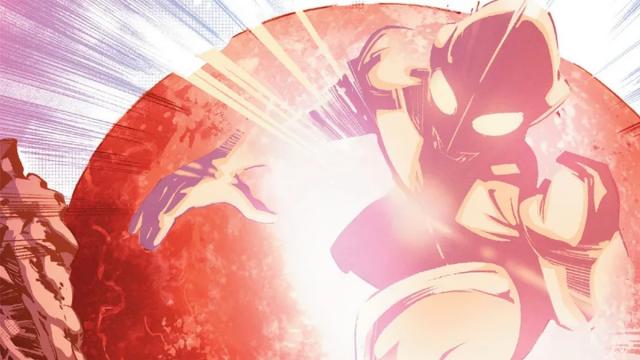Don’t come into the first issue of Marvel’s new Ultraman series expecting big superheroes punching equally big monsters. At least, not yet: this is, after all, the retelling of the classic tokusatsu series’ origins, and a loving one at that. But Rise of Ultraman’s opening is a crucial reminder of what Ultraman and his human allies are always fighting for.
Out this week and from the minds of Kyle Higgins (a fundamental architect on another comic book reboot of toku heroes, in the form of Boom Studios’ excellent Power Rangers series), Mat Groom (Self/Made), Francesco Manna, Espen Grundetjern, and Ariana Maher — and featuring backup story art from Michael Cho, Ed McGuiness, and Gurihiru — Rise of Ultraman #1 re-introduces us to the original Ultraman series’ premise, updated to a contemporary setting rather than its original 1966 one. But despite that, many of its roots are still reaching to the core of what Ultraman is about, even if, sandwiched between two cosmic arrivals that bookend the first issue, Rise #1 doesn’t actually have much in the way of an actual Ultraman in it.
We’re introduced through the eyes of Cadet Akiko “Kiki” Fuji to the United Science Patrol, a secretive international organisation with more than a few suitably Marvel-ian SHIELD vibes that has access to strange tech even our whiz kid young technician isn’t allowed to truly investigate and understand. Her brash superior officers, in the form of Captain Muramatsu and Director Ichinotani, present blockades within the text of the narrative to her desire to know more about just what the USP does, while metatextually, captions describing USP tech and processes are selectively filtered, giving readers the same heady mix of intrigue and frustration Kiki feels.

That same mix also comes to the fore when we meet the “actual” protagonist of Rise: Shin Hayata, the man we’ve known for over 50 years as the very first Ultraman. And yet, Rise is cleverly disarming in how it handles him, mining the very human and relatable relationship between Kiki and Shin for all it’s worth. It’s clear that Shin as we meet him is not the protagonist. Even if he is already familiar with the world of the USP as Kiki knows it, perhaps even moreso in some ways, he’s locked out, presented as a failure — denied success in the USP’s enrollment program where Kiki succeeded. It’s an alternate lens on the issue’s fascination with mystery and secrets that makes Rise read less like an action comic and more like a conspiracy thriller. Even if, largely, the conspiracy might be “just when is the giant dude gonna show up and mess up a kaiju or six?”
This human focus doesn’t just amplify the conspiracy thriller vibes of Rise’s large world, it also makes the moment a kaiju does show up legitimately feel terrifying. Knowing that this premise does not yet have an Ultraman to swoop in, transform, and save the day — coupled with the fact it’s a reimagining of a fiction most readers may not be intimately familiar with already, so you don’t know if a character is necessarily “safe” just because they were in the TV show — already amplifies the threat when Kiki and Muramatsu head into the field. But Rise cleverly frames its first kaiju encounter not as this ginormous, Godzilla-esque moment of large-scale destruction. Its creatures skulk in warehouses and under acqueducts, lit up only by the torches and gunfire of the USP. In keeping things so intimate at first, everything feels rather literally ground-level, setting the stage for the escalation of what will come when Ultraman himself shows up.

Crucially, Rise, while diverging from what we know about classic Ultraman in some ways to keep things fresh, also retains the Ultra franchise’s legacy in some clever ways during the process as well. Shin, Kiki, and the USP as we know it may exist in the present day, but they are not the origins of Rise’s world of kaiju and the superpowered aliens that battle them. From the lingering, mysterious seeds of just what happened to Dan Moroboshi (a familiar name to Ultra fans as the star of Ultra Seven, and a major figure in the series’ long-running mythos), to the excellently pulpy, black and white backup story Ultra Q (inspired by the very first series in the Ultra franchise, an X-Files-esque show from the ‘50s that didn’t feature an Ultraman-style protagonist), Rise of Ultraman makes its world of kaiju and secretive agencies feel immediately fleshed out and filled with legacy.
And it’s a legacy of the humans that put themselves on the front lines to defend their home from monsters that runs through it. Yes, Shin Hayata and the Ultrawarrior from the stars may bond together in the issue’s climax, the moment we have been waiting to unfold. But even as we look forward to epically scaled fights as the series progresses, it’s important that Rise makes it clear that it’s here to focus on the people behind (and, uh, far far below, from his perspective) Ultraman’s battles to come.

Leave a Reply